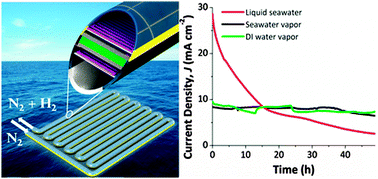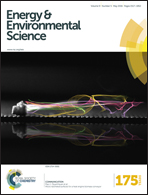Solar hydrogen production from seawater vapor electrolysis†
Abstract
Solar photovoltaic utilities require large land areas to produce power equivalent to a conventional fossil fuel utility, and also must be coupled to cost-effective energy storage to overcome the intermittency of sunlight and provide reliable, continuous energy generation. To target both of these disadvantages, a method was demonstrated to produce hydrogen fuel from solar energy by splitting seawater vapor from ambient humidity at near-surface ocean conditions. Using a proton exchange membrane electrolyzer with seawater-humidified air at 80% relative humidity at the anode and dry N2 at the cathode, sufficient electrolysis current density was maintained to operate near the maximum energy-conversion point when driven by a triple-junction amorphous Si solar cell of equivalent area. Fluctuations in atmospheric water content were demonstrated to have minimal effect on the solar-to-hydrogen efficiency, remaining ∼6% with relative humidity ≥30%. Direct solar-driven H2 production from seawater vapor was maintained at >4.5 mA cm−2 for >90 hours. The calculated solar-to-hydrogen conversion efficiency before and after 50 h of operation changed from 6.0% to 6.3% using an ambient seawater humidity feedstock as compared to a drop from 6.6% to 0.5% using liquid seawater feedstock.


 Please wait while we load your content...
Please wait while we load your content...